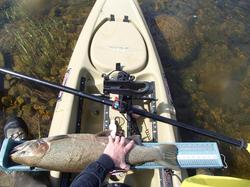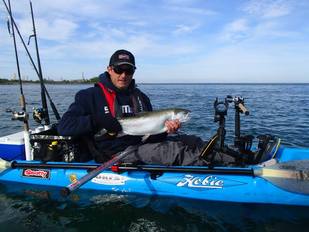|
Jeff Wall | Nomad Adventures [email protected] This article is intended to provide basic information to anyone wishing to take advantage of the spring Great Lakes Steelhead fishery. Although we are targeting migratory rainbow trout, there are many incidental catches that fill our day with joy and help us learn tactics for catching other species we may encounter. Rainbow Trout (Oncorhynchus mykiss) is a species of salmonid which is native to the cold water tributaries of Pacific Asia and North America. Steelhead is an anadromous(sea-run), or in this case, lake-run form of Coastal Rainbow Trout(Oncorhynchus mykiss Irideus) that have been introduced to Great Lakes tributaries. These fish spend their first 1-2 years in the tributaries, then enter the Great Lakes, to later migrate back to their natal streams when they reach spawning maturity. Primary spawning runs occur in the Great Lakes tributaries from late March to late May depending on the winter. Season and HabitatTiming as they say is everything. Especially on a sunny, warm spring day where the lake hasn't been stirred up much. If the water is clear and sun is high, then I'm already off the water looking at my pictures of the day's catch. A light wind is not a bad thing either provided it is in your favour. I prefer to fish a small chop when fishing steelhead and other minnow eaters. It displaces the baitfish more and allows for a wider, deeper zone to troll through. Fishing can be equally as good in the last two hours of daylight too. Finding a lightly wind blown warm shoreline near a creek or river can give whole new perspective on Great Lakes kayak fishing if you time it right! A spot where the sun has warmed all day long with a decent outflow nearby will start to get a trickle of minnows just before dusk that can provide fast and furious action as the sun disappears. Most of the time you are fishing less than 20' of water. Fish are shallow as 5' when the sun comes up and usually stay in less than 20' until then light starts to really penetrate then water. Try to find temperature gradients close to a mud line as they are your best indicator of where to start fishing. The transitioning water colour from brown to green is the area you want to focus on the most. This is where the bait are hanging out to avoid being in plain sight. Zig-zag trolling in and out of the mud line will surely get you bit. This is the season where kayaks have a real advantage over motorboats because of the relatively silent trolling capability. There is no need to run inline planer boards unless you do it to clear other rods when trolling multiple. If you have a leg propelled kayak like a Hobie Mirage series then things are even that much more simplified with hands free fishing. We primarily target spring Steelhead before they enter the tributaries to go about their reproductive business. Anytime that conditions allow and you feel you are capable of dealing with them is the right time to go. This article is not about safety so if you feel there may be a risk and are not comfortable with it, then do not go. Steelhead begin entering Great Lakes rivers in October and can still be around in early June. Spring runs are more consistent from April to mid May. Once they are safely higher up in the system, it is our practice to give them free passage. Although we are not afraid to go and pound on a fresh run of fish near the lower stretches of rivers, we prefer letting those who passed the gauntlet, to carry on and make lots of future angling opportunities. Especially on rivers that yield wild fish! Locating and Timing The old spawned out warrior in this picture is a catch we try to avoid but can't always when targeting migrating fish around rivers. For this reason we tend to concentrate our efforts in the lake near the river, rather than in it. He took about 5 mins to revive even in icy cold water. A chrome bright fish in the spring does not mean it is a fresh arrival! Many steelhead finish their spawning ritual before the river season opens, and they are almost fully healed from their wounds, leaving them with their beautiful silver sheen. These kelts are the most sensitive of the lot. They are extremely hungry and feed ravenously on anything they can find. They are also very susceptible to death if hooked and and fought to exhaustion with less oxygen in the warming rivers. They cannot recover since they have no reserve body mass to fall back on. Please do not target these fish!  This spring hen was caught in Lake Huron near a major tributary. She was fully recovered from spawning and caught June 1 gorging herself on shiners when she hit a Live Target Rainbow Smelt. Anything resembling a shiner or smelt style minnow and fished near a river outlet on the Great Lakes will get bit... by something. It will most likely be a steelhead, coho salmon, or brown trout but could be any number of other species following the bait. Move around in the lake until you mark bait or spot it. Glenn Coin | [email protected]
on February 18, 2015 at 4:29 PM, updated February 19, 2015 at 10:13 AM Update: The ice continues to cover more of Lake Ontario each day. The latest report shows that the lake was 82.6 percent covered as of Wednesday. Syracuse, N.Y. -- The amount of ice covering Lake Ontario has reached near-record levels, and scientists say that's the result of two cold winters in a row. One result of all the ice is that Central and Northern New York are getting less lake effect snow than they would otherwise. Extensive ice cover reduces evaporation, the raw ingredient for lake effect snow. On Tuesday, ice covered 78.5 percent of the surface area of Lake Ontario. That comes close to the record of 85.7 percent, set on Feb. 19, 1979. This much ice is highly unusual on Lake Ontario, which generally has the least ice cover of any of the five Great Lakes. The long-term average for Lake Ontario, in fact, is just 11 percent. Ontario is particularly deep compared to its surface, so it retains heat better than the other lakes and is less likely to freeze. What's happening this year is that the lake never fully warmed up after last year's cold winter and relatively cool summer. Those cooler waters, combined with with a bitterly cold January and February this year, create lots of ice. "The lake lost a lot of heat last year and it never regained it during the summer," explained George Leshkevich, a physical scientist at the Great Lakes Environmental Research Laboratory in Michigan. "We're starting out with cooler water temperatures, and with these cold temps we've been having the lake is just in a condition where it can form substantial ice cover." |
FISHING NEWS ONTARIOOntario and Great Lakes region salmon, steelhead, and migratory trout fishing articles, information, news, and reports. Stay up to date on our most recent trips, events, tournaments, and general news on adventure fishing and kayak fishing in Ontario and Canada. Archives
April 2021
Categories
All
Links |



 RSS Feed
RSS Feed